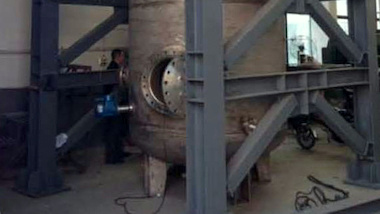| Extending intergranular normal-stress distributions using symmetries of linear-elastic polycrystalline materials |
| Extending intergranular normal-stress distributions using symmetries of linear-elastic polycrystalline materials
Dr. Samir El Shawish from the Reactor Engineering Division at Jožef Stefan Institute published the research artic... |
| Young researcher Aljoša Gajšek was awarded EUROfusion Engineering Grant |
| The EUROfusion Engineering Grant (EEG) was awarded to 16 candidates from a wide range of 55 different competence areas, interesting for development of fusion technologies. The EEG was also awarded to young researcher Aljoša Gajšek from th... |
| EMUG meeting |
| Previous week, between April 12 and 14, the EMUG (European MELCOR and MACCS User Group) meeting was held in Slovenia, organized by the Reactor Engineering Division, JSI in cooperation with the Paul Scherrer Institute from Switzerland. The meeting was a... |
| Grain boundary stresses in elastic materials |
| Grain boundary stresses in elastic materials
Dr. Samir El Shawish and dr. Timon Mede from the Reactor Engineering Division at Jožef Stefan Institute published an article “Grain boundary stresses in elastic materials&rdqu... |
| Joint European Torus (JET) device released a record 59 MJ of sustained fusion energy |
| Researchers from the EUROfusion consortium, including JSI researchers, used the Joint European Torus (JET) device to release a record 59 MJ of sustained fusion energy. The breakt... |
| Turbulent Flow over Confined Backward-Facing Step: PIV vs. DN |
| Boštjan Zajec, Marko Matkovič, Nejc Kosanič, Jure Oder, Blaž Mikuž, Jan Kren and Iztok Tiselj from the Reactor Engineering Division at Jožef Stefan Institute published the article “Turbul... |
| Prof. dr. Leon Cizelj elected as the president of the European Nuclear Society (ENS) |
| Prof. dr. Leon Cizelj was elected as the president of the European Nuclear Society (ENS; www.euronuclear.org) for 2022 and 2023 at the proposal of the Nuclear Society of Slo... |
| New experimental campaign - Investigation of Temperature Fluctuations in a Fully Developed Channel Flow |
| New experimental campaign - Investigation of Temperature Fluctuations in a Fully Developed Channel Flow
Dr. Mohit Sharma and colleagues have performed turbulent heat transfer experiments with the heated thin fo... |
| A single grain boundary parameter to characterize normal stress fluctuations in materials with elastic cubic grains |
| Dr. Samir El Shawish and dr. Timon Mede from the Reactor Engineering Division at Jožef Stefan Institute, in collaboration with dr. Jeremy Hure from Université Paris-Saclay, CEA (France) published the article &l... |
| Modelling of premixed layer formation in stratified fuel–coolant configuration |
| Janez Kokalj, dr. Mitja Uršič and dr. Matjaž Leskovar from the Reactor Engineering Division at Jožef Stefan Institute published the article »... |
| Validation of a morphology adaptive multi-field two-fluid model considering counter-current stratified flow with interfacial turbulence damping |
| Dr. Matej Tekavčič from the Reactor Engineering Division at Jožef Stefan Institute in collaboration with researchers from the Institute of Fluid Dynamics, Helmholtz-Zentrum Dresden-Rossendorf (Germany) published the article »... |
|

 VisitorsPartnersMedia
VisitorsPartnersMedia SI
SI
